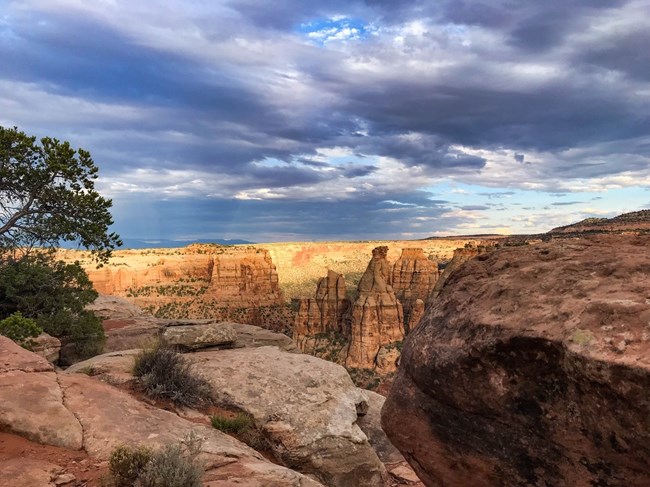Learn about NRCAs
The Natural Resource Condition Assessment (NRCA) Program provides framework, funding, and publishing support to parks to aid in the synthesis and documentation of natural resource conditions. Condition assessment reports are a tool to describe selected park resources, and record a snapshot of their current condition, identify trends, and identify potential or current threats and stressors. Understanding the condition and trend of natural resources is key for parks and NPS planners to appropriately prioritize and allocate stewardship resources.

Photo by Victoria Stauffenburg/NPS.
Most of Colorado National Monument rises more than 2,000 feet above the Grand Valley of the Colorado River. Situated at the edge of the Uncompahgre Uplift, the park is part of the greater Colorado Plateau, which also embraces such geologic wonders as Grand Canyon, Bryce Canyon, and Arches National Parks. Pinyon-juniper woodland densely covers the higher elevations above the cliffs, and sparsely covers canyon sides. Thick stands of Gambel oak (Quercus gambelii) are found in the upper reaches of some drainages. Riparian habitat occurs along dry washes where seeps, springs, and intermittent flows during rain events support diverse biota.
Traditional NRCA Report: 2016
In an effort to better understand the natural resources and processes present in Colorado National Monument, a Natural Resource Condition Assessment was conducted and published in 2016. This assessment was a collaborative effort between the National Park Service and St. Mary’s University of Minnesota. This team chose 21 resource topics to evaluate:
- Pinion-jumiper woodlands and savannah |
- Small mammals |
||||||||
- Sagebrush shrublands and shrub-steppe |
- Mountain lion |
||||||||
- Riparian habitats and large dry washes |
- Bighorn sheep |
||||||||
- Seeps, springs, and tinaja habitats |
- Kit fox |
||||||||
- Mixed salt desert scrub and semi-desert grassland |
- Bats |
||||||||
- Canyon walls and monolith vegetation communities |
- Air Quality |
||||||||
- Montane shrubland |
- Dark Night Skies |
||||||||
- Herpetofauna |
- Viewscape |
||||||||
- Birds |
- Soundscape |
||||||||
- Raptors |
- Paleontological resources |
||||||||
|
|
- Geologic features |
For those components with sufficient available data, the overall condition varied. Only two topics (riparian habitats/large dry washes and bighorn sheep) were determined to be in good condition. Five topics (pinyon-juniper woodlands/savannas, seeps, springs and tinaja habitats, birds, air quality and paleontological resources) were of moderate concern. Birds were the only topic where the available data were sufficient enough to assign a trend. At this time, the bird community exhibits a stable trend. Three topics were determined to be of significant concern (kit fox, dark night skies, and viewscape). Understanding the condition of these resources can help managers prioritize management objectives and better focus conservation strategies to maintain the health and integrity of these ecosystems.
For other reports and natural resource datasets visit the NPS Data Store.
Source: NPS DataStore Collection 7765 (results presented are a subset). To search for additional information, visit the NPS DataStore.
Last updated: June 28, 2022
